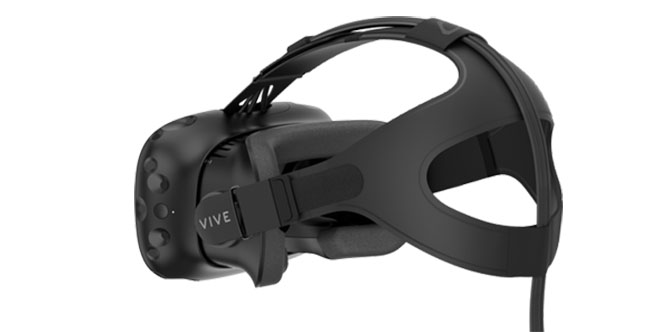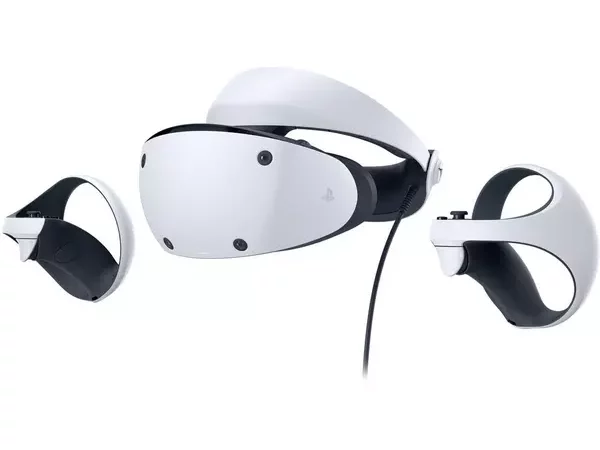With virtual reality (VR), you can tour the universe in a spaceship, view a potential house before buying, perform a medical operation, practice a sales pitch and create 3D art, all from the comfort of your own home.
VR simulates different environments using a headset and motion sensors, and is being used in a wide range of applications, from education to well-being.
In this guide, we’ll explore:
- What is virtual reality?
- VR headsets
- VR headset accessories
- Motion Sickness
- Roomscale, Seated, and Standing
- Applications of VR
- Software to create VR experiences
- VR vs AR
Current age of virtual reality
The popularity with modern VR began in 2010, when Palmer Luckey created the first prototype of a VR headset that would evolve into the Oculus Rift. He launched a Kickstarter crowdfunding campaign in 2012 and raised $2.4m, bringing VR into the public interest.
Two years later, Facebook’s CEO, Mark Zuckerberg, bought the company for $2bn.
- Read more about the History of VR.

The Oculus Rift Kickstarter campaign raised $2.4m and introduced VR into the public image.
Several competitors have emerged since then, including the HTC Vive Focus, Sony’s PlayStation VR, and the Pico Neo headsets.
Meanwhile thousands of developers are making VR experiences, film-makers are exploring the potential for documentaries and animation, while Facebook and YouTube are creating 360-degree videos.
What is virtual reality?
Virtual reality is the term used to describe a three-dimensional, computer generated environment which can be explored and interacted with by a person. That person becomes part of this virtual world or is immersed within this environment and whilst there, is able to manipulate objects or perform a series of actions to determine what happens in the environment.
VR usually has these 4 characteristics:
- Believable: You feel like you’re in your virtual world through what you see and hear.
- Immersive: As you move your head around, what you see changes as well, just as it would in real life.
- Computer-generated: VR worlds are usually created with complex 3D computer graphics that change in real time as we move.
- Interactive: You can interact with different objects in the scene, whether it’s pressing a button or opening a door.
If you’re interested, this article covers a longer definition of VR.
VR Headsets
The backbone of VR is the headset. These devices use sensors and screens to immerse users in a virtual world, but they come in different types, from mobile to standalone to tethered headsets.
Mobile vs PC vs Standalone
Virtual reality headsets fit into three broad categories, mobile, PC or standalone, each with their pros and cons.
Mobile VR headsets (Retiring but Still Used)

These headsets use your smartphone as the screen and processing power. While once popular, manufacturers have stopped developing new mobile VR devices as the industry has shifted toward more robust standalone and tethered headsets.
However, because phones aren’t designed specifically for VR, they can’t offer the best visual experiences, and are underpowered compared with PC or game console-based VR. In addition, there is currently no positional tracking with mobile VR. You can look around an environment from a single point, however you can’t look around objects.
Examples:
- Daydream View (not supported anymore)
- Gear VR (not supported anymore)
- Merge VR
Standalone VR headsets

Standalone VR headsets offer a wireless experience with all the necessary hardware built directly into the headset itself. These are more powerful and accessible than mobile VR headsets, and they don’t require a phone or PC to function.
Examples:
- Meta Quest series
- Pico Neo series
- Vive Focus series / XR Elite
- Apple Vision Pro
PC / Console connected VR headsets

These headsets provide a more immersive experience at a higher price point. Most of these headsets are tethered with cables from the headset to an external piece of hardware to power the headset.
The trade-off, besides the clunky cables, is the price. The least expensive tethered options are currently around $400, and with the Rift and the Vive, you’ll need a powerful PC to run them, while the PS VR requires a PlayStation 4 at the minimum.
Examples:
- Vive Cosmos
- Oculus Rift (being phased out for the Meta Quest)
- HP Reverb G2
- PlayStation VR
VR Apps

VR devices have their own app stores, similar to smartphone app stores, where you can browse and download games and apps.
Some of these stores are accessed using the device itself, while others – the Meta and Steam stores, for example – can be browsed on your computer.
Popular VR Headsets

PlayStation VR2
- The Sony PlayStation VR2, follow up to the original Sony PlayStation VR, provides a powerful gaming experience to the PS5. Featuring 4K HDR graphics, subtle headset vibrations, intelligent eye tracking and haptic feedback, it provides another level to Sony’s gaming experience.
- Cost: ~$550
- App store: PlayStation Catalog

Pico 4
- With 4K+ resolution, a 105-degree field of vision, world-leading eye tracking, and spatial audio, the Pico 4 is a great headset choice. The Pico 4 Enterprise is also available for businesses, with further customization options.
- Cost: ~$450

Meta Quest 3
- The Meta Quest 3 is an advanced all-in-one VR system yet. Explore an expansive library of games and immersive experiences with unparalleled freedom.
- Cost: ~$499
- App store: Meta Quest Store

HTC Vive Pro 2
- HTC has always had great offers in the VR headset market, the HTC Vive Pro 2, whilst at the top end in price, is a hugely powerful headset. Boasting 5K graphics, a 120-degree field of view, and advanced precision room tracking for a safer experience even in a multi-user scenario.
- Cost: ~$1399 (Headset only is available for $799 for those with existing HTC controllers and other accessories)
HP Reverb G2
- The HP Reverb G2 was developed in collaboration with Valve and Microsoft, delivering a more immersive, comfortable, and compatible experience.
- Cost: ~$550-650, you’ll also need a powerful PC

Recent Release: Apple Vision Pro
- Apple launched the Vision Pro on February 2nd 2024, an AR/VR headset that offers innovative technology. Relying solely on hand movement, eye movements, and Siri-activated voice commands, the headset is controller-free. Featuring 4K graphics, spatial audio and advanced sensor tracking, it’s an impressive headset, but at a high price point, we shall wait and see if it becomes a popular headset in the market.
- Cost: ~$3499
Accessories for the VR headset
Aside from the headset, there are plenty of accessories and peripherals.
Hand controllers
Headsets like the Meta Quest, Pico Neo and HP Reverb G2 come with two controllers, one for each hand. These controllers are tracked in 6DoF.

Smell
Companies such as OVR Technology are developing scent technology for virtual reality.
Users testing out the device can try out demos like picking and smelling a virtual rose. When you pull the rose away, the smell instantly disappears instead of lingering like a perfume. That effect is due to the OVR hardware.
Motion Tracking:
Advanced VR setups like the Vive Pro and Meta Quest 3 offer precision motion tracking, adding more realism to your virtual experience.
Haptic Feedback:
Devices like the PlayStation VR2 and Meta Quest provide vibrations and sensory feedback to make interactions feel more lifelike.
Motion Sickness
VR motion sickness happens when your brain receives conflicting signals about movement in the environment around you, and your body’s relation to it. In VR, this essentially means that if you are standing still and the virtual environment around you is moving, you disturb the brain’s equilibrium and you start to feel nauseous.
Symptoms include: Dizziness, nausea, sweating, headaches, eye strain, and general discomfort.
To minimize motion sickness:
- Start with shorter sessions.
- Use smoother movement settings in games.
- Ensure your VR space is well-lit.

To learn more about what VR motion sickness is, what causes it, and how to minimise it so you can enjoy your favourite games and simulations, read this article:
Roomscale, Seated, and Standing

There are 3 main types of movement and positioning tailored for each play area size: roomscale, seated, and standing.
With Roomscale VR, you set a boundary or play area and can move freely and physically around that area in the game. With these games, you can physically move around your space to interact with the simulated environment.
With Seated and Standing, the user stays roughly in the same place and uses different movement options (usually on the hand controller) to move instead of psychically moving through a space.
Applications of VR
There are many applications of VR, from engineering to entertainment to recruitment. It’s best known currently for gaming, however there are plenty of other useful application of virtual reality:
- Automotive industry: VR is transforming the automotive industry by enabling manufacturers to design, prototype, and test vehicles in virtual environments.
- Healthcare: Surgeons can practice procedures in a risk-free environment. VR is also used for pain management and mental health treatment.
- Gaming: Immersive games like Beat Saber and Half-Life: Alyx offer entertainment on a new level.
- Retail: Virtual try-ons, showroom experiences, and e-commerce have been revolutionized with VR.
- Architecture
- Education: VR creates interactive, immersive learning experiences, making difficult subjects easier to understand.
- Enterprise Training: VR is increasingly used as a tool for employee training, particularly in areas like public speaking, leadership, sales, and difficult conversations.
- Military & Aviation: Training simulations for fighter pilots and military personnel use VR for high-risk scenarios.
- Real Estate: Virtual house tours allow potential buyers to view homes remotely.
Read about key industries that use VR: Applications of VR
Wherever it’s too dangerous, expensive or impractical to do something in reality, virtual reality is the answer. From trainee fighter pilots to medical applications trainee surgeons, virtual reality allows us to take virtual risks in order to gain real world experience
As the cost of virtual reality goes down and becomes more mainstream, you can expect more serious applications, such as ones for education and productivity.
Software to create VR experiences
Unity vs. Unreal Engines
Unreal Engine and Unity are two of the most popular game engines available to create VR experiences. While some developers choose to create their apps natively without the use of either of these, the majority of VR projects use one or the other.
Unreal Engine typically has a higher quality output, at the expense of ease of use. However, over time the difference between the two is minimal and the choice between the two comes down to preference.
It’s worth noting they have slightly different business models: Unity charges a yearly fee for their Pro version, whereas Unreal Engine charges 5% royalties when you monetize your game and your lifetime gross revenues exceed $1,000,000 USD.
VR applications built with Unreal Engine:
VR applications built with Unity:
Virtual reality vs augmented reality
Augmented Reality (AR) overlays digital elements on top of your live view of the physical surroundings, often by using the camera on a smartphone or lens on a headset. Examples of AR experiences include Snapchat lenses, Magic Leap and the Pokémon Go game.
VR completely immerses you in the virtual world and shuts out your physical surroundings. Using VR devices such as HTC Vive, Oculus Quest or Pico VR, users can be transported into a number of real-world and imagined environments.
- Read more about the differences: Augmented Reality vs Virtual Reality




